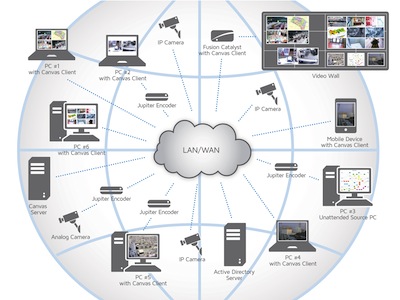Jupiter Introduces 'Canvas' Collaborative Solution

Follow us
Add us as a preferred source on Google
Jupiter Systems has introduced its new Canvas visualization and collaboration solution that allows users in the control room, across campus, and around the world to see, share, annotate and collaborate on video and desktop streams.
- Canvas allows users to share video streams and captured desktop streams over an enterprise network. The Canvas client-server software is secure, easy to configure, and simple to administer, according to the company. Canvas is the solution for any enterprise employing video streams in the conduct of its mission and a distributed team, such as traffic management centers, public transportation agencies, electrical and water utilities, private and public security, law enforcement, emergency operations centers, telecom and data NOCs, petroleum producers and refiners, and manufacturing operations, among others.
- “The release of Canvas is critically important for Jupiter Systems, our customers and the industry,” said Brady O. Bruce, vice president of marketing and strategic alliances at Jupiter. “Traditionally, video display walls have been isolated, limited to one location. At the traditional display wall, operators, managers and others can review and analyze information together and determine what action to take, but they must all be in the same room at the same time. Canvas moves beyond those limits on participation.”
- “Instead, Canvas allows authorized users to see, share and collaborate across the enterprise no matter where they are located. Users can access content wherever and whenever it is needed,” Bruce said. “For many years Jupiter has provided Windows-based processors that make any display wall into a PC desktop. With Canvas, every PC desktop can now be a display wall. The ability to visualize display wall content and collaborate from a remote PC or mobile device is essential in the enterprise and it will become the new industry standard,” said Bruce.
- At the heart of the new system is a 'canvas' — a sharable collage of visual objects. A canvas can include a source viewer for video and desktop streams, a grid for organizing objects, a label that can have dynamic properties and display data from network sources, and a frame that can include a title. A toolkit allows other widgets to be custom made by Jupiter, integrators, or the end user.
- Canvas provides object-level security for all sources, eliminating inadvertent disclosure of restricted content. For example, if a canvas of video sources is shared with a remote user, only those sources the remote user has permission to view are displayed. Source windows for which the user lacks appropriate permissions will be blank.
- System access requires user authentication by the customer’s own Active Directory. Secure login is accomplished using the standard user name and password combination established by the customer’s IT department. Windows Single Sign-On (SSO) is supported.
- User permissions, including access to specific sources, operations on canvases, and access to remote keyboard and mouse operation are assigned and managed by the system administrator. The role-based security architecture makes management of large numbers of users and permissions easy and flexible, according privileges to cadres of users sharing a common role in the enterprise.
- Canvas is established as a client-server application. Customers choose the number of Canvas Clients desired for Windows devices and add the Canvas Server software to networked server hardware. Canvas Encoders can be added for any remote PCs that will serve as Canvas sources.
scn Newsletter
A daily selection of the top stories for AV integrators, resellers and consultants. Sign up below.
TOPICS
The AVNetwork staff are storytellers focused on the professional audiovisual and technology industry. Their mission is to keep readers up-to-date on the latest AV/IT industry and product news, emerging trends, and inspiring installations.
